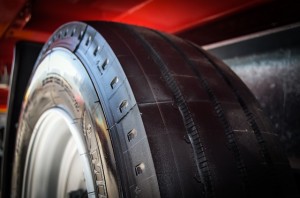 Print a Sign-In Sheet | Spanish Version
Print a Sign-In Sheet | Spanish Version
A miner should always:
- Check tires and rims:
- Prior to mounting for damage or defects.
- After mounting to see if they are properly seated.
- Inspect the flange and side ring to make sure they are correctly positioned.
- Inspect all clamps and wheel nuts:
- For wheel vibration due to loose nuts.
- For loose clamps that can cause rim slippage or detachment of the rim and tire from the vehicle.
- Replace all damaged or weak parts:
- Check for metal cracks, dents, and signs of metal fatigue.
- Check for:
- Excessive ring butting and side ring play.
- Mismatched rim parts.
- Replace all severely rusted rims:
- Check all rims for excessive corrosion which could cause weakness.
- Check for proper fitting of all rings due to potential buildup of rust.
- Inflate all tires in a safety cage:
- To prevent injury from a flying piece of metal due to a weak rim part.
- To prevent injury from a flying ring.
- Deflate tires prior to demounting:
- Check for damage to rim and rings.
- Check for an unseated ring.
- Remove the tire by deflating it first if the ring appears to be unseated.
- Remove the valve core to ensure complete deflation.
A miner should never:
- Work carelessly:
- Always follow standard operating procedures for a given tire and rim task.
- Take unnecessary chances:
- Always be sure of the proper procedure of mating rim and wheel parts.
- Always ask questions of a more knowledgeable miner or distributor if there is a question regarding a certain tire and rim procedure.
- Operate a vehicle on a single tire of a dual assembly:
- Always inflate both tires to recommended balanced pressures before operating the vehicle.
- Always check the capacity of each tire to determine if it is being exceeded.
- Exceed the load rating of the tires:
- Always make sure rims are not cracked or out-of-round.
- Always increase the tire ply rating or size, or both, if the vehicle is to have excessive heavy loads.
- Always use correct size rims for certain tire sizes.
- Always stay within the specific tire pressure.
- Use undersized tires:
- Always check for chafing, pinching, and premature failure of rim due to undersizing.
- Always check for bead or sidewall failure of the tire.
- Take one manufacturer’s rims and mix with another manufacturer’s rims:
- Always match components parts and rims by make, size, and type.
- Take a flat tire and reinflate it without first carefully inspecting the complete tire, wheel assembly, and rim for unsafe conditions:
- Always inspect the ring for potential damage and make certain it is secure in the gutter before inflation.
KEMI does not assume liability for the content of information contained herein. Safety and health remain your responsibility. This information is to be used for informational purposes only and not intended to be exhaustive or a substitute for proper training, supervision, or manufacturers’ instructions/recommendations. KEMI, by publication of this information, does not assume liability for damage or injury arising from reliance upon it. Compliance with this information is not a guarantee or warranty that you will be in conformity with any laws or regulations nor does it ensure the absolute safety of any person, place, or object, including, but not limited to, you, your occupation, employees, customers, or place of business.

